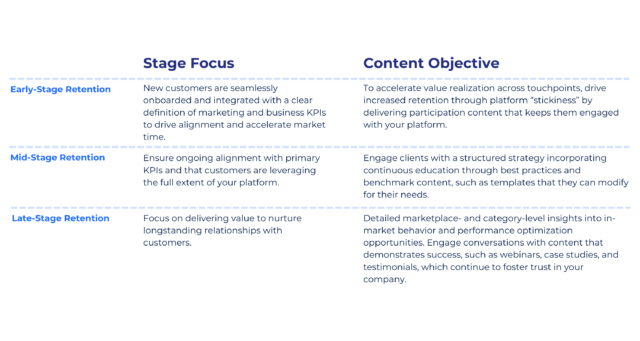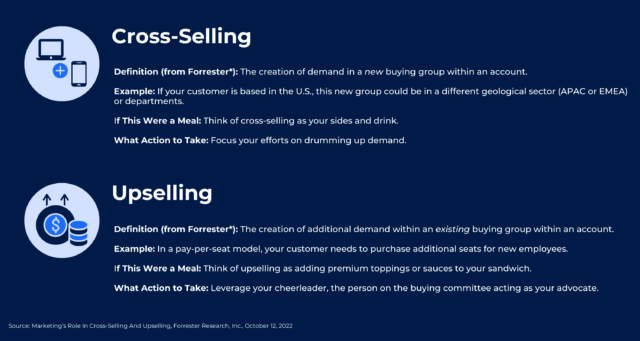
One of the well-known adages around customer retention is that converting an existing customer costs five times less than gaining a new one. Another includes the Pareto Principle, where 80% of your sales could simply come from 20% of your existing customer base. With so many opportunities within your customer base, no wonder B2B marketers are starting to emphasize building out a stronger retention strategy.
In many organizations, the primary role of the marketing team is to influence the top-of-funnel (TOFU) and middle-of-funnel (MOFU) motions to build and fuel the sales pipeline. However, where these companies fall short is in seeing the value of account-based marketing (ABM) throughout the entire length of the customer relationship—from first interaction to signing the dotted line, and from onboarding to expansion that fosters a true partnership.
Your account-based expansion strategy is stronger when you view it within the larger scope of your retention strategy. If we consider retention as the maintenance of customer relationships, your expansion efforts create more depth in those relationships. As customers use the product in more advanced ways, you can expand their usage to ensure they get as many benefits from it as possible. And value realization leads to a rise in customer trust, which will be enthusiastically maintained as you continue to provide exceptional service that positively impacts their goals.
Learn more about the relationship between customer expansion and retention, and how your ABM strategy fortifies deeper insights into your customers’ needs.
Post-Sales Data Indicates Strong Customer Relationships and Reception to Expansion Campaigns
The customer lifecycle begins with a signed contract (when the lead converts into a new customer). But understanding other customer details, such as what products they adopted, their implementation schedule, and the terms of the contract, influences both your retention and customer expansion strategies.
A comprehensive dataset from first- and third-party sources including customer purchase history, preferences, and interactions is crucial for practical customer retention efforts. Analyzing this data helps you uncover patterns and better understand customer behavior to strengthen relationships with existing customers.
Your first-party data offers a wealth of precise, individualized insights into customer preferences, interactions, and behaviors that enable you to identify where they are in the buyer’s journey—whether they’re still building mastery with your product or if they may be interested in expansion. Accounts continuing to interact with ABM content and messaging after the sale may be ripe for cross-sell or upsell activities, while those with a drop in engagement behavior might signal that they require more nurturing.
Third-party intent data is useful to identify any active competitor research that might indicate a flight risk. Knowing what customers are researching in terms of competitors indicates that you may need to revisit your product roadmap so you can serve your customers’ needs. Focus your retention efforts on these accounts with nurturing that communicates how you can help them achieve their goals. Coordinate with the customer success team to provide any enablement materials, like user guides, to ensure they are aware of your product’s capabilities. You can also run an expansion campaign that provides information about the next tier of service or another product line, as it’s also likely that these customers have realized they have a new problem that they are either just beginning to research or weren’t aware that your solution could solve.
Retention Stages Influence the Timing for Customer Expansion Campaigns
Typically, when leads have just converted into customers, they’re done being sold to (at least for the time being). To understand when to begin focusing on retention efforts, which require onboarding and ramping up in product usage, you need to map the customer journey out by retention stage. This leads to deepening the understanding and timing to launch a more receptive expansion campaign at the right time.
The following retention chart outlines the three retention stages, what that stage’s focus is, and what content pairs best with that stage to accomplish building a long-term partnership:

Content plays a critical role in moving current customers through retention stages. As they complete onboarding in the early stages of retention, you want to continue paving the path toward mastery with your product. If you are a financial platform, for example, you may introduce templates for everyday tasks, like a software as a service (SaaS) financial model template that reports on important metrics for your business, or more robust processes, such as a board meeting deck or the month-end close that has many parts to check off, that customers can modify for their needs. That would be the type of adoption you monitor as an advancement into the mid-stage retention portion of the customer lifecycle, as it’s indicative of enthusiasm for and mastery with the product. The templates ideally become part of their day-to-day workflow, which further makes your product essential as they provide value (in terms of saving time and lessening redundancies in data resolution).
Post-sale engagement with more sophisticated educational materials, like whitepapers, product user guides, templates, and articles that outline advanced features or benchmarks for success, is also a sign of successful enablement and the potential for expansion. As this content continues to educate customers on the value your product delivers, the more they download and use, the more they trust your brand as a partner they need to accomplish their goals. Customers will often share this feedback with their customer success managers (CSMs), who will take these cues and signals to introduce additional product lines, upgrade to the next tier with more premium features, or add additional features before advancing tiers.
Demand within the Customer Group Dictates the Type of Expansion Campaign
Remember that customers are still part of an account—which expands across geographies and departments. While upselling and cross-selling are both means of customer expansion that impacts retention, each expansion campaign has different signals and considerations, which can only be clarified as you collect more data around customer behavior.
Expansion campaigns are often considered as post-sales initiatives that help extend the customer’s lifetime value (CLV), which impacts company revenue goals. Many companies aim for a quick sales cycle because they want to make up the customer acquisition cost as quickly as possible, and expansion campaigns are one way to quickly make back those costs while growing the account.
As stated above, timing is everything: You can’t expand an account when they’re not ready. Which is why customer success, marketing, and sales teams need to pay attention to customer behavior and cues that indicate when customers may be open to an upsell or cross-sell.

An upsell is any sale within the existing buying group—the direct customer group the company has interacted with. A cross-sell considers demand in a new buying group within the account. For example, it could be a different division of the customer’s company or a different geographic region. If your customer is based in North America, but their division in APAC expresses interest in your product, it would be considered a cross-sell.
Customer success teams have more access to verbal and written cues from customers due to being the main points of contact in the customer relationship. But marketing teams can monitor engagement metrics, such as site visitations, webinar attendance, and downloads across an account to point out where there may be opportunities to expand the relationship. Intent data and customer research behavior also help you track customer health to anticipate what customers may need to maintain a healthy relationship with your product, whether that’s a case study that serves as a testimonial and builds brand rapport while communicating successful product mastery, or a white paper that surveys their industry and shows how your services help others succeed.
Product engagement data is also vital in your post-sales ABM engagement efforts. Both the customer success and marketing teams monitor the customer onboarding and product adoption processes to understand customer behavior, roadblocks, and opportunities to optimize the experience. Marketing and product teams can both then implement any feedback to ensure the product, content, and messaging provide enough clarity and simplicity to educate and motivate customers through the processes so they can quickly realize your product’s value in their day-to-day operations.
Retention Rate Impacts Brand Reputation, Which Influences Customer Expansion Campaigns’ Success
A high retention rate, largely due to your expansion efforts, strengthens your brand’s reputation, drives customer loyalty, and provides insight into your product roadmap through customer feedback that is eventually implemented into your company’s offerings. With a stronger reputation and ample feedback, marketers can proactively anticipate what content keeps customer engagement high, which strengthens the success of expansion and retention efforts.
Reputation matters: High customer retention is a sign of customer satisfaction with your product and customer service. Longtime customers with multiple renewals and upgrades are also indicative of how your ABM engagement efforts across organization bring in high value accounts, which impact your brand perception. Strong brand perception also helps with word-of-mouth marketing, whether customers refer leads your way or share their successes on social media. Customers pay attention to other customers’ successes, especially if they’re in the same marketplace or industry, and will want to learn about what they need to adopt to gain similar success.
Churn also impacts brand reputation. Low retention signals to potential customers that the brand may not be trustworthy or provide a functional product. When customers churn, marketing needs to focus on TOFU initiatives to fill the pipeline with leads while also running reengagement campaigns for any opportunities lost in the funnel or churned customers who are showing interest.
Expansion campaigns move faster, use less resources, and are more cost-effective than launching new campaigns due to the buying group already being engaged with your company. Working through your customer base and finding cross-sell and upsell opportunities allows you to deepen your customer relationship while quickly impacting your company’s retention metrics and bottom line.
Don’t Just Maintain Your Accounts. Grow with Them with Better Intent Signals from Madison Logic
Pre- and post-sales data is vital to understand how to retain customers—and how to expand with them. This data lives in your customer relationship management (CRM) and marketing automation platform (MAP), which are susceptible to late updates and errors that could quickly cause you to miss signals to launch expansion campaigns at the opportune time.
Don’t want to wait until customers verbalize interest in expanding their product usage—anticipate their asks by observing their actions and always providing a personalized experience through content and messaging that reaches them exactly when they need it.
Madison Logic provides a holistic view of account data that allows you to quickly dive into intent signals and actions your accounts are taking so you can proactively engage accounts with expansion campaigns at the optimal time. With ML Insights, you can quickly see how accounts score based on real-time intent data from over 20 million companies worldwide to give you a better sense of what content will drive higher engagement with your accounts, leading to better engagement with your customer expansion campaigns. ML Insights also quickly aligns sales and marketing efforts faster as it provides the data for better insights so you can quickly capitalize on opportunities.
Ready to take your customer expansion campaign from the maintenance phase to exponential growth with your ABM strategy?
Download the Customer Expansion: ABM for Cross-Selling and Upselling Blueprint to learn more about how you can deepen the relationship between your retention and expansion efforts. Then, request a demo to discuss how your data can fuel your ABM campaigns to take them to the next level of performance and attract high-value accounts that will see you as a truly valuable partner.



